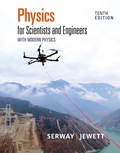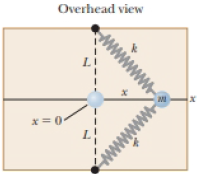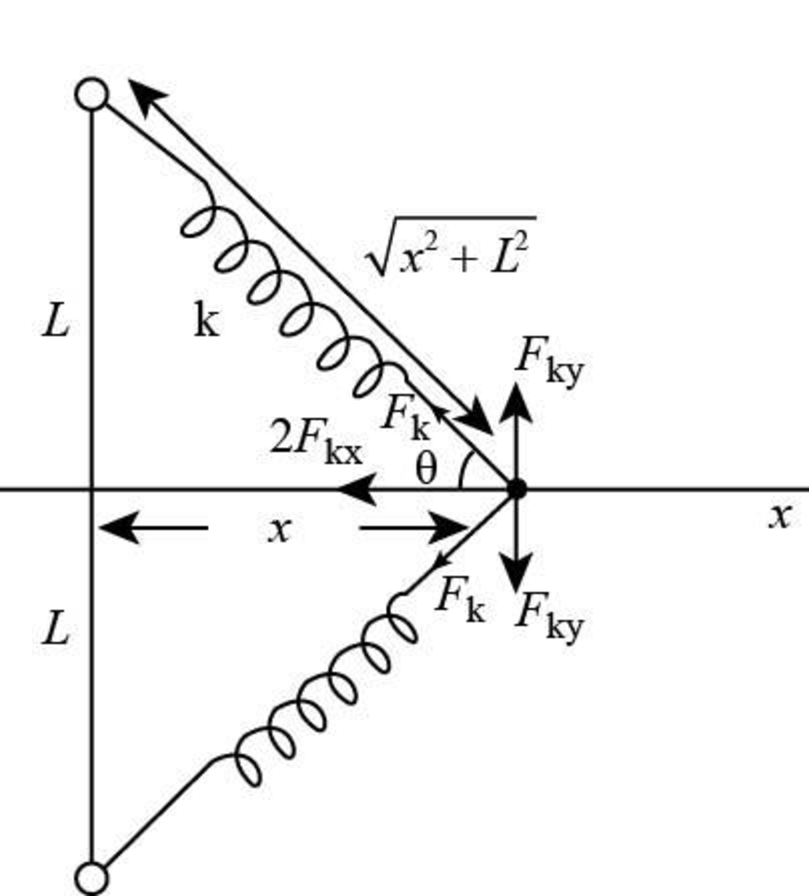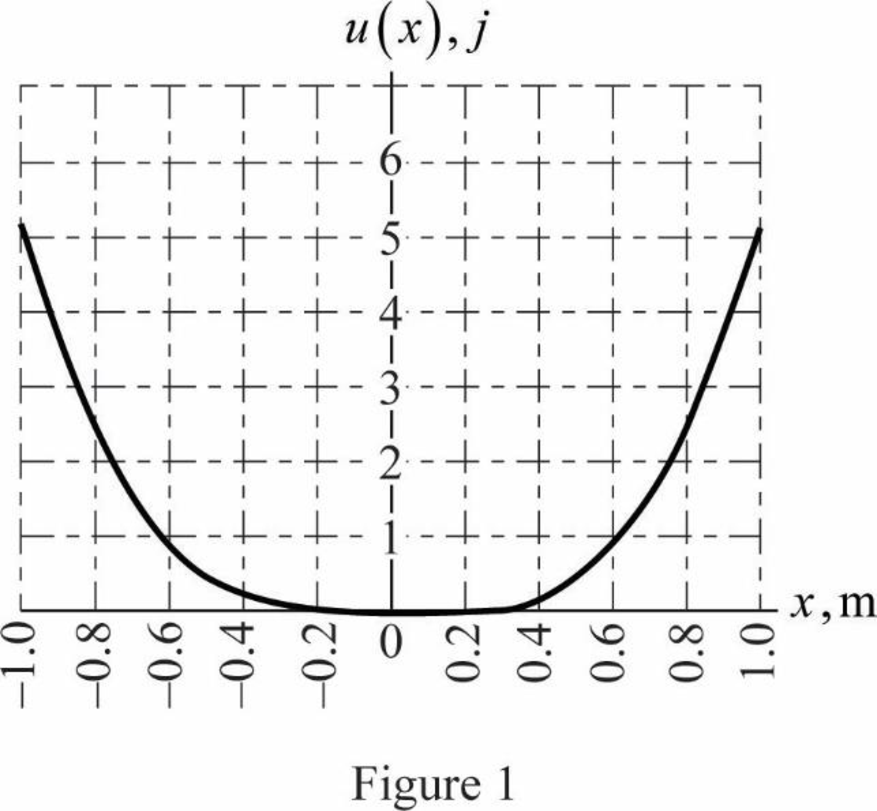
Concept explainers
A particle of mass m = 1.18 kg is attached between two identical springs on a frictionless, horizontal tabletop. Both springs have spring constant k and are initially unstressed, and the particle is at x = 0. (a) The particle is pulled a distance x along a direction perpendicular to the initial configuration of the springs as shown in Figure P7.50. Show that the force exerted by the springs on the particle is
(b) Show that the potential energy of the system is
(c) Make a plot of U(x) versus x and identify all equilibrium points. Assume L = 1.20 m and k = 40.0 N/m. (d) If the panicle is pulled 0.500 m to the right and then released, what is its speed when it reaches x = 0?
Figure P7.50

(a)
The force exerted by the spring on the particle is
Answer to Problem 50CP
The force exerted by the spring on the particle is
Explanation of Solution
The mass of the particle is
The free body diagram of the given case is as shown in the figure below.

Write the expression for the extension in the spring
Here,
Write the expression for the new length after stretching
Here,
Substitute
From the figure (1) the net force in
Write the expression for the net force in
The negative sign is due to the direction of the force in the negative direction.
Here,
From the free body diagram, write the expression for the value of
Write the expression for the formula for the spring force
Substitute
Substitute
Write the expression for the force exerted by the spring on the particle.
Substitute
Conclusion:
Therefore, the force exerted by the spring on the particle is
(b)
The potential energy of the system is
Answer to Problem 50CP
The potential energy of the system is
Explanation of Solution
From part (a) the force exerted by the spring on the particle
Write the expression for the potential energy of a system
Conclusion:
Substitute
Therefore, the potential energy of the system is
(c)
The plot of
Answer to Problem 50CP
The plot for

Explanation of Solution
The equilibrium points are the points at which the values of the force and the potential energy have the minimum value in order to have higher stability in the system.
Write the expression for the potential energy of the system
Substitute
Thus, the potential energy of the system
The plot

The equilibrium points are the point at the potential energy is zero. In the above plot the minimum potential energy is at
Form the graph the equilibrium point is for
Conclusion:
Therefore, the plot for
(d)
The speed of the particle.
Answer to Problem 50CP
The speed of the particle is
Explanation of Solution
The potential energy of the system
Substitute
Thus, the potential energy of the system is
The potential energy is converted in to the kinetic energy to follow the law of conservation of momentum.
Here,
Rearrange the above equation for
Conclusion:
Substitute
Therefore, speed of the particle is
Want to see more full solutions like this?
Chapter 7 Solutions
EBK PHYSICS FOR SCIENTISTS AND ENGINEER
- A block of mass m = 2.50 kg is pushed a distance d = 2.20 m along a frictionless, horizontal table by a constant applied force of magnitude F = 16.0 N directed at an angle = 25.0 below the horizontal as shown in Figure P6.3. Determine the work done on the block by (a) the applied force, (b) the normal force exerted by the table, (c) the gravitational force, and (d) the net force on the block. Figure P6.3arrow_forwardA block of mass 0.500 kg is pushed against a horizontal spring of negligible mass until the spring is compressed a distance x (Fig. P7.79). The force constant of the spring is 450 N/m. When it is released, the block travels along a frictionless, horizontal surface to point , the bottom of a vertical circular track of radius R = 1.00 m, and continues to move up the track. The blocks speed at the bottom of the track is = 12.0 m/s, and the block experiences an average friction force of 7.00 N while sliding up the track. (a) What is x? (b) If the block were to reach the top of the track, what would be its speed at that point? (c) Does the block actually reach the top of the track, or does it fall off before reaching the top?arrow_forwardA particle moves in one dimension under the action of a conservative force. The potential energy of the system is given by the graph in Figure P8.55. Suppose the particle is given a total energy E, which is shown as a horizontal line on the graph. a. Sketch bar charts of the kinetic and potential energies at points x = 0, x = x1, and x = x2. b. At which location is the particle moving the fastest? c. What can be said about the speed of the particle at x = x3? FIGURE P8.55arrow_forward
- A block of mass m = 2.50 kg is pushed a distance d = 2.20 m along a frictionless horizontal table by a constant applied force of magnitude F = 16.0 N directed at an angle = 25.0 below the horizontal as shown in Figure P5.8. Determine the work done by (a) the applied force, (b) the normal force exerted by the table, (c) the force of gravity, and (d) the net force on the block. Figure P5.8arrow_forwardA block of mass m = 2.50 kg is pushed a distance d = 2.20 m along a frictionless horizontal table by a constant applied force of magnitude F = 16.0 N directed at an angle = 25.0 below the horizontal as shown in Figure P5.8. Determine the work done by (a) the applied force, (b) the normal force exerted by the table, (c) the force of gravity, and (d) the net force on the block. Figure P5.8arrow_forwardA block of mass m = 2.50 kg is pushed a distance d = 2.20 m along a frictionless, horizontal table by a constant applied force of magnitude F = 16.0 N directed at ail angle = 25 below the horizontal as shown in Figure P7.5. Determine the work done on the block by (a) the applied force, (b) the normal force exerted by the table, (c) the gravitational force, and (d) the net force on the block.arrow_forward
- If the net work done by external forces on a particle is zero, which of the following statements about the particle must be true? (a) Its velocity is zero. (b) Its velocity is decreased. (c) Its velocity is unchanged. (d) Its speed is unchanged. (e) More information is needed.arrow_forwardA 4.00-kg particle moves from the origin to position ©, having coordinates x = 5.00 m and y = 5.00 m (Fig. P6.42). One force on the particle is the gravitational force acting in the negative y direction. Using Equation 6.3, calculate the work done by the gravitational force on the particle as it goes from O to © along (a) the purple path, (b) the red path, and (c) the blue path. (d) Your results should all be identical. Why? Figure P6.42 Problems 42 through 45.arrow_forwardA 4.00-kg particle moves from the origin to position , having coordinates x = 5.00 m and y = 5.00 m (Fig. P7.31). One force on the particle is the gravitational force acting in the negative y direction. Using Equation 7.3, calculate the work done by the gravitational force on the particle as it goes from O to along (a) the purple path, (b) the red path, and (c) the blue path, (d) Your results should all be identical. Why? Figure P7.31arrow_forward
- A nonconstant force is exerted on a particle as it moves in the positive direction along the x axis. Figure P9.26 shows a graph of this force Fx versus the particles position x. Find the work done by this force on the particle as the particle moves as follows. a. From xi = 0 to xf = 10.0 m b. From xi = 10.0 to xf = 20.0 m c. From xi = 0 to xf = 20.0 m FIGURE P9.26 Problems 26 and 27.arrow_forwardAs shown in Figure P7.20, a green bead of mass 25 g slides along a straight wire. The length of the wire from point to point is 0.600 m, and point is 0.200 in higher than point . A constant friction force of magnitude 0.025 0 N acts on the bead. (a) If the bead is released from rest at point , what is its speed at point ? (b) A red bead of mass 25 g slides along a curved wire, subject to a friction force with the same constant magnitude as that on the green bead. If the green and red beads are released simultaneously from rest at point , which bead reaches point first? Explain. Figure P7.20arrow_forwardThe system shown in Figure P5.43 is used to lift an object of mass m = 76.0 kg. A constant downward force of magnitude F is applied to the loose end of the rope such that the hanging object moves upward at constant speed. Neglecting the masses of the rope and pulleys, find (a) the required value of F, (b) the tensions T1, T2, and T3, and (c) the work done by the applied force in raising the object a distance of 1.80 m. Figure P5.43arrow_forward
 Principles of Physics: A Calculus-Based TextPhysicsISBN:9781133104261Author:Raymond A. Serway, John W. JewettPublisher:Cengage Learning
Principles of Physics: A Calculus-Based TextPhysicsISBN:9781133104261Author:Raymond A. Serway, John W. JewettPublisher:Cengage Learning College PhysicsPhysicsISBN:9781305952300Author:Raymond A. Serway, Chris VuillePublisher:Cengage Learning
College PhysicsPhysicsISBN:9781305952300Author:Raymond A. Serway, Chris VuillePublisher:Cengage Learning College PhysicsPhysicsISBN:9781285737027Author:Raymond A. Serway, Chris VuillePublisher:Cengage Learning
College PhysicsPhysicsISBN:9781285737027Author:Raymond A. Serway, Chris VuillePublisher:Cengage Learning Physics for Scientists and Engineers, Technology ...PhysicsISBN:9781305116399Author:Raymond A. Serway, John W. JewettPublisher:Cengage Learning
Physics for Scientists and Engineers, Technology ...PhysicsISBN:9781305116399Author:Raymond A. Serway, John W. JewettPublisher:Cengage Learning Physics for Scientists and Engineers: Foundations...PhysicsISBN:9781133939146Author:Katz, Debora M.Publisher:Cengage Learning
Physics for Scientists and Engineers: Foundations...PhysicsISBN:9781133939146Author:Katz, Debora M.Publisher:Cengage Learning Physics for Scientists and EngineersPhysicsISBN:9781337553278Author:Raymond A. Serway, John W. JewettPublisher:Cengage Learning
Physics for Scientists and EngineersPhysicsISBN:9781337553278Author:Raymond A. Serway, John W. JewettPublisher:Cengage Learning





